|
|
|
Sort Order |
|
|
|
Items / Page
|
|
|
|
|
|
|
| Srl | Item |
| 1 |
ID:
193455
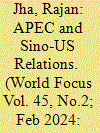

|
|
|
|
|
| Summary/Abstract |
The paper tries to examine the changing contour of Sino-US relations in the context of churning in the geostrategic landscape at the time when the US is simultaneously engaged in conflict in two theaters i.e. Ukraine and West Asia. The San Francisco meeting held in November 2023 reflects a desire on the part of the US to manage its great power competition with China. On the Chinese side, the debilitating impact of tariff war with the US, its denial of advanced technology to its companies provides an ideal setting for China to seek a modus vivendi with the US. Hence this meeting has profound ramification at global and regional levels including in India.
|
|
|
|
|
|
|
|
|
|
|
|
|
|
|
|
| 2 |
ID:
193446
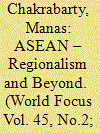

|
|
|
|
|
| Summary/Abstract |
While coming to the conclusion, it should be stated that in order to ensure political conditions of Southeast Asia, the ASEAN has struggled a lot in order to implement various efforts. But the darker side is that the implementations have been little bit slow. But the ASEAN sharply reflects the spirit and sense of belongings. It has been succinctly stated bythe former Malaysia Prime Minister Tun Dr. Mahathir Mohammad and it is the primesecret of ASEAN’s success. The key to the success have definitely been the 5 Cs. (Consolidation, Consultation, Consensus, Caring and Cornerstone).
|
|
|
|
|
|
|
|
|
|
|
|
|
|
|
|
| 3 |
ID:
193449
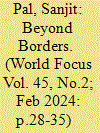

|
|
|
|
|
| Summary/Abstract |
This ar ticle explores the dynamic and complex landscape of strategic interactions in the vast Indo-Pacific region. In recent years, the Indo-Pacific has become the centre of global strategic competition. Begins with theconceptual framework and dynamics of Indo-Pacific, the article explores the current strategic priorities of major players like China, the United States, India, and regional alliances like ASEAN. Special attention is given to the maritime domain, where territorial disputes, resource competition, and naval presence contribute to the evolving strategic landscape.
|
|
|
|
|
|
|
|
|
|
|
|
|
|
|
|
| 4 |
ID:
193457
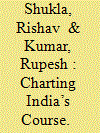

|
|
|
|
|
| Summary/Abstract |
The Indo-Pacific region stands as a crucial arena for global politics and trade, and India’s role in this context is increasingly significant. As the article highlights, India’s maritime strategy is influenced by a delicate balancing act between regional cooperation, economic interests, and national security concer ns. The impor tance of India’s evolving partnerships with key players in the Indo- Pacific, such as the United States, Japan, and Australia, as well as its engagement with regional forums like the Quad.
|
|
|
|
|
|
|
|
|
|
|
|
|
|
|
|
| 5 |
ID:
193452
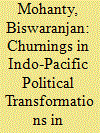

|
|
|
|
|
| Summary/Abstract |
India’s role in defence and strategic collaboration has conveyed the Maldives faster to its broader Indo-Pacific security space in South Asia. India has an important role as the net security provider in its region mostly with
respect to China’s encouragement in South Asia’s maritime states like the Maldives. The Maldives can guide regional power political decisions regarding India and China. This is clarified in the background of political changes accepted for development support between the Maldives, China and India. Solih’s government
produced ideas to restart teamwork with India and assess China’s commitment with the Maldives.
|
|
|
|
|
|
|
|
|
|
|
|
|
|
|
|
| 6 |
ID:
193454


|
|
|
|
|
| Summary/Abstract |
India promotes connectivity at a high level through its Look East policy, Connect Central Asia, the Asia-Africa Growth Corridor, and free trade agreements and alliances. However, problems with infrastructure, especially in the Northeast and Myanmar, are proving to be obstacles to these endeavors.Recognizing the importance of regional infrastructure, Japan and the EU approach China’s objectives with caution.
|
|
|
|
|
|
|
|
|
|
|
|
|
|
|
|
| 7 |
ID:
193445


|
|
|
|
|
| Summary/Abstract |
Indo-Pacific region has become a scene of Great Game by major Global Powers –China, USA, West European states, and Japan resulting in political rivalry. While China wants to asser t its geopolitical interest, Western powers want to contain China. Japan has adopted policy of geo-economic strategy to support the ASEAN countries and to strengthen Balance of Power policy of the West.
|
|
|
|
|
|
|
|
|
|
|
|
|
|
|
|
| 8 |
ID:
193456


|
|
|
|
|
| Summary/Abstract |
The great power competition in the Indo-Pacific will continue in coming years. However, a lot will also depend on strategic choices made by the middle and small powers that would play a critical role in deciding the trajector y and outcome of this rivalry. All types of power would be employed to achieve strategic gains over rivals. One cannot speculate how this competition would end. There is no clear answer whether this rivalry would turn into a war in times to come.
|
|
|
|
|
|
|
|
|
|
|
|
|
|
|
|
| 9 |
ID:
193447
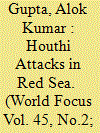

|
|
|
|
|
| Summary/Abstract |
The present events must not be read and understood in isolation or as an isolated instance. It has certainly given rise to a new geopolitical reality on the globe. US is still the net security provider on the globe and in different regions both on landas well as in maritime regions. On many occasions US has also demonstrated its the challenging position that it faces as a security provider owing to its close alliance with Israel. US have been quite smart in its response through retaliatory actions.
|
|
|
|
|
|
|
|
|
|
|
|
|
|
|
|
| 10 |
ID:
193450


|
|
|
|
|
| Summary/Abstract |
Every opportunity presents challenges, and the IPEF is no different. Overall, the IPEF offers an alternative economic platform, providing India the opportunity to integrate its economy with the mega economic arrangement in the Indo-Pacific region. The significance of India’s role in the IPEF is emphasized by its innovative approach, linking trade with national security. The IPEF also acts as a framework aligning economic and security interests, particularly for the US, India, and other members dedicated to countering China’s strategic use of economic influence.
|
|
|
|
|
|
|
|
|
|
|
|
|
|
|
|
| 11 |
ID:
193459


|
|
|
|
|
| Summary/Abstract |
China and India will continue to sustain their bilateral as well as multilateral engagements despite the
sporadic turbulences. So long as both countries respects each other’s sovereignty, which is central to their foreign policy, it is unlikely that a major fallout will occur in the near future. India has repeatedly made its stand clear of its independent foreign policy that it does not live under the shadow of any big power, it has weapon deals with the US and France as well, India wants to diversify its contacts and today is a part of both global as well as regional engagement.
|
|
|
|
|
|
|
|
|
|
|
|
|
|
|
|
| 12 |
ID:
193458


|
|
|
|
|
| Summary/Abstract |
In the intricate tapestr y of Indo-Pacific geopolitics, the nuclearization of the Korean Peninsula emerges as a pivotal force shaping regional dynamics and demanding nuanced strategic considerations from India. As of 2022, the region stands at a crossroads, with the evolving scenarios on the Korean Peninsula reverberating across maritime trade routes, economic hubs, and strategic alliances.The challenges posed by Korean nuclearization are multifaceted. Heightened security concerns, potential arms buildups, and diplomatic intricacies confront India with the imperative to navigate a delicate balance between safeguarding its national interests and contributing to regional stability.
|
|
|
|
|
|
|
|
|
|
|
|
|
|
|
|
| 13 |
ID:
193453


|
|
|
|
|
| Summary/Abstract |
While we come to the conclusion, it should be said that in its current form, the QUAD remains relatively lightly institutionalized. In fact, it is neither a security arrangement nor a trade group. The major objective of the QUAD may be said to provide “tangible benefits” to the Indo-Pacific, bolster people-to-people ties. The major intent
is to thwart China’s growing regional influence. The QUAD also focuses on shared interests among group members in the matter of strengthening economic resilience and reducing dependencies on autocracies.If we look to it from a critical point of view, the QUAD—now stands at a crossroads as it enters its third phase.
|
|
|
|
|
|
|
|
|
|
|
|
|
|
|
|
| 14 |
ID:
193448
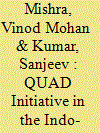

|
|
|
|
|
| Summary/Abstract |
This research paper delves into the Quad (Quadrilateral Security Dialogue) alliance’s role and significance in shaping the geopolitical landscape of the Indo-Pacific region. Through a comprehensive analysis of the strategic imperatives driving the QUAD countries - the United States, Japan, India, and Australia - this study examines the alliance’s evolving objectives, regional partnerships, and the impact on maritime security, economic cooperation, and diplomatic alignments.
|
|
|
|
|
|
|
|
|
|
|
|
|
|
|
|
| 15 |
ID:
193451


|
|
|
|
|
| Summary/Abstract |
Democracy and multilateralism of the Quad members has been juxtaposed against authoritarianism of China.China and Russia have accused the United States to selectively talk about rule-based international order, while violating the same to perpetuate their interests. China even accused the U.S. of having intentions to convert the Quad into an “Indo-Pacific NATO” and encouraging “cold war mentality” in the region that could foment geo-political rivalry.
|
|
|
|
|
|
|
|
|
|
|
|
|
|
|
|
|
|
|
|
|